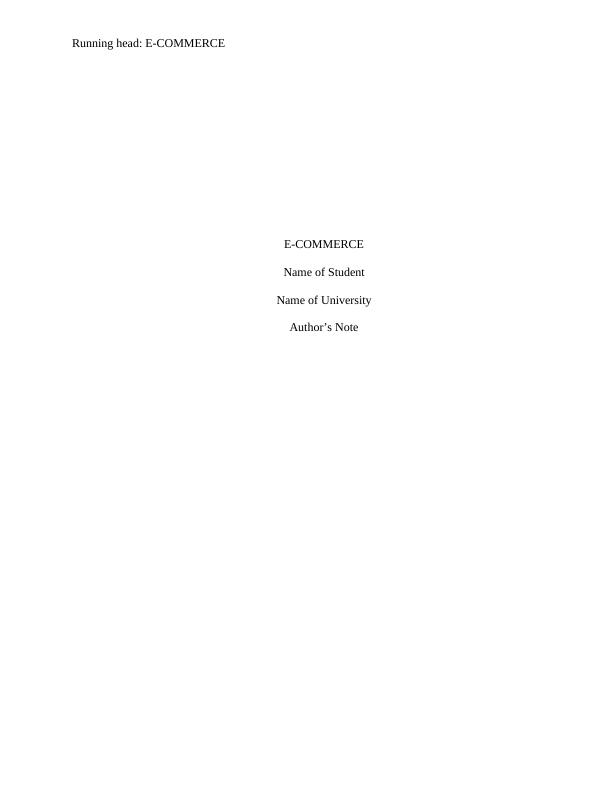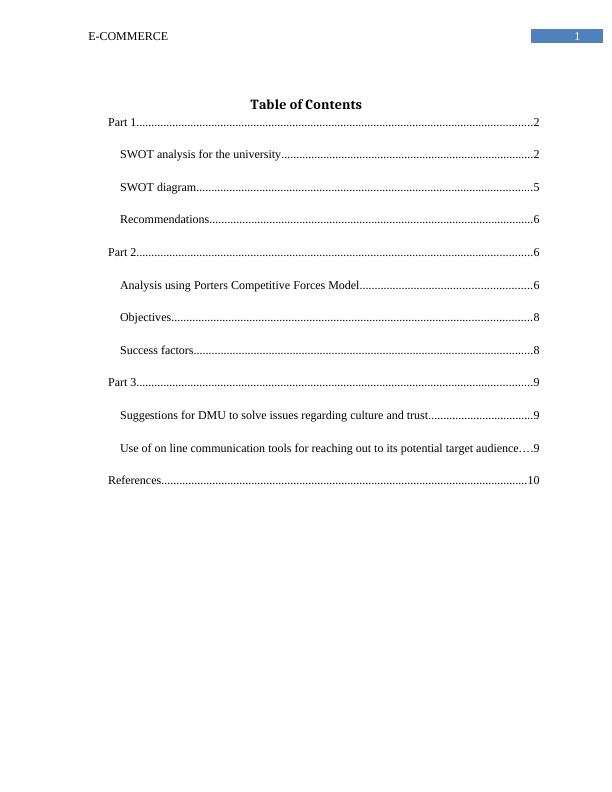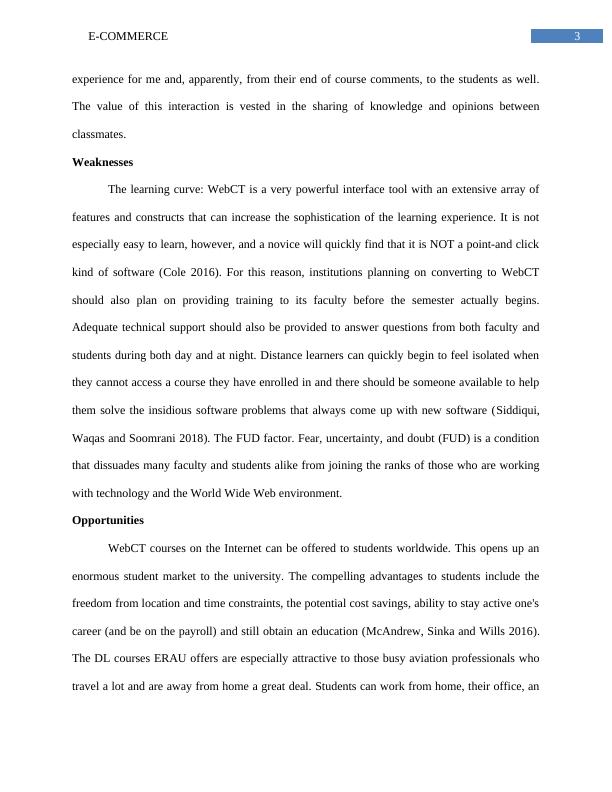SWOT Analysis for Distance Learning
Added on 2023-04-11
13 Pages2493 Words184 Views
Running head: E-COMMERCE
E-COMMERCE
Name of Student
Name of University
Author’s Note
E-COMMERCE
Name of Student
Name of University
Author’s Note

1E-COMMERCE
Table of Contents
Part 1....................................................................................................................................2
SWOT analysis for the university....................................................................................2
SWOT diagram................................................................................................................5
Recommendations............................................................................................................6
Part 2....................................................................................................................................6
Analysis using Porters Competitive Forces Model.........................................................6
Objectives........................................................................................................................8
Success factors.................................................................................................................8
Part 3....................................................................................................................................9
Suggestions for DMU to solve issues regarding culture and trust...................................9
Use of on line communication tools for reaching out to its potential target audience....9
References..........................................................................................................................10
Table of Contents
Part 1....................................................................................................................................2
SWOT analysis for the university....................................................................................2
SWOT diagram................................................................................................................5
Recommendations............................................................................................................6
Part 2....................................................................................................................................6
Analysis using Porters Competitive Forces Model.........................................................6
Objectives........................................................................................................................8
Success factors.................................................................................................................8
Part 3....................................................................................................................................9
Suggestions for DMU to solve issues regarding culture and trust...................................9
Use of on line communication tools for reaching out to its potential target audience....9
References..........................................................................................................................10

2E-COMMERCE
Part 1
SWOT analysis for the university
Strengths
If we define strength as something that we are good at or a characteristic that makes us
more competitive, then we should also have something to benchmark strength against. In the
current study, we will use conventional, face-to-face (FTF) instructional delivery systems as the
basis for comparison as we discuss Distance Learning (DL) on the Internet.
One of the obvious benefits of DL via the Internet is rapid access. DL courses can be
delivered to students living anywhere in the world as long as they have access to the Internet.
The asynchronous mode in which ERAU CDL courses are provided is ideal for allowing our
students the freedom to work on course work when it is convenient for them (Smith 2016). In
face-to-face (FTF) classes, the material is normally presented during the day at a time convenient
to the instructor and the institution. When students are free from the constraints of learning place
and time, they can better manage their career and family responsibilities in a way that best suits
them. For busy aviation professionals, this is truly a characteristic that gives DL an advantage
over FTF environments (Yao and Meng 2018). If student-centered learning is ~better," then DL
on the Internet wins because it is obviously more ~user-friendly" than FTF.
Effective learning environments should involve frequent and personalized interactions
among the learners and the instructor. In the pilot MAS 606 class, there were over 1200 ~hits"
recorded on the WebCT counter. This level of interaction far surpassed any face-to-face class
(Gill, Ricciardi and Bates 2017). In addition to the sheer number of hits during the semester, the
quality of the interaction and the depth of the exchanges between students was a defining
Part 1
SWOT analysis for the university
Strengths
If we define strength as something that we are good at or a characteristic that makes us
more competitive, then we should also have something to benchmark strength against. In the
current study, we will use conventional, face-to-face (FTF) instructional delivery systems as the
basis for comparison as we discuss Distance Learning (DL) on the Internet.
One of the obvious benefits of DL via the Internet is rapid access. DL courses can be
delivered to students living anywhere in the world as long as they have access to the Internet.
The asynchronous mode in which ERAU CDL courses are provided is ideal for allowing our
students the freedom to work on course work when it is convenient for them (Smith 2016). In
face-to-face (FTF) classes, the material is normally presented during the day at a time convenient
to the instructor and the institution. When students are free from the constraints of learning place
and time, they can better manage their career and family responsibilities in a way that best suits
them. For busy aviation professionals, this is truly a characteristic that gives DL an advantage
over FTF environments (Yao and Meng 2018). If student-centered learning is ~better," then DL
on the Internet wins because it is obviously more ~user-friendly" than FTF.
Effective learning environments should involve frequent and personalized interactions
among the learners and the instructor. In the pilot MAS 606 class, there were over 1200 ~hits"
recorded on the WebCT counter. This level of interaction far surpassed any face-to-face class
(Gill, Ricciardi and Bates 2017). In addition to the sheer number of hits during the semester, the
quality of the interaction and the depth of the exchanges between students was a defining

3E-COMMERCE
experience for me and, apparently, from their end of course comments, to the students as well.
The value of this interaction is vested in the sharing of knowledge and opinions between
classmates.
Weaknesses
The learning curve: WebCT is a very powerful interface tool with an extensive array of
features and constructs that can increase the sophistication of the learning experience. It is not
especially easy to learn, however, and a novice will quickly find that it is NOT a point-and click
kind of software (Cole 2016). For this reason, institutions planning on converting to WebCT
should also plan on providing training to its faculty before the semester actually begins.
Adequate technical support should also be provided to answer questions from both faculty and
students during both day and at night. Distance learners can quickly begin to feel isolated when
they cannot access a course they have enrolled in and there should be someone available to help
them solve the insidious software problems that always come up with new software (Siddiqui,
Waqas and Soomrani 2018). The FUD factor. Fear, uncertainty, and doubt (FUD) is a condition
that dissuades many faculty and students alike from joining the ranks of those who are working
with technology and the World Wide Web environment.
Opportunities
WebCT courses on the Internet can be offered to students worldwide. This opens up an
enormous student market to the university. The compelling advantages to students include the
freedom from location and time constraints, the potential cost savings, ability to stay active one's
career (and be on the payroll) and still obtain an education (McAndrew, Sinka and Wills 2016).
The DL courses ERAU offers are especially attractive to those busy aviation professionals who
travel a lot and are away from home a great deal. Students can work from home, their office, an
experience for me and, apparently, from their end of course comments, to the students as well.
The value of this interaction is vested in the sharing of knowledge and opinions between
classmates.
Weaknesses
The learning curve: WebCT is a very powerful interface tool with an extensive array of
features and constructs that can increase the sophistication of the learning experience. It is not
especially easy to learn, however, and a novice will quickly find that it is NOT a point-and click
kind of software (Cole 2016). For this reason, institutions planning on converting to WebCT
should also plan on providing training to its faculty before the semester actually begins.
Adequate technical support should also be provided to answer questions from both faculty and
students during both day and at night. Distance learners can quickly begin to feel isolated when
they cannot access a course they have enrolled in and there should be someone available to help
them solve the insidious software problems that always come up with new software (Siddiqui,
Waqas and Soomrani 2018). The FUD factor. Fear, uncertainty, and doubt (FUD) is a condition
that dissuades many faculty and students alike from joining the ranks of those who are working
with technology and the World Wide Web environment.
Opportunities
WebCT courses on the Internet can be offered to students worldwide. This opens up an
enormous student market to the university. The compelling advantages to students include the
freedom from location and time constraints, the potential cost savings, ability to stay active one's
career (and be on the payroll) and still obtain an education (McAndrew, Sinka and Wills 2016).
The DL courses ERAU offers are especially attractive to those busy aviation professionals who
travel a lot and are away from home a great deal. Students can work from home, their office, an

End of preview
Want to access all the pages? Upload your documents or become a member.
Related Documents
SWOT Analysis and Recommendations for De Montfort Universitylg...
|13
|2553
|410
E-Commerce System: SWOT Analysis, Porter's Five Forces, and Critical Success Factorslg...
|19
|2704
|92
E-Commerce Systemslg...
|7
|851
|62
E-Commerce: SWOT Analysis, Objectives, Critical Success Factors and KPIslg...
|9
|1784
|475
IMAT5211- E-Commerce: Assignment | Distance learninglg...
|9
|1987
|243
SWOT and Porter's Five Forces Analysis of De Montfort University's Distance Learning Programlg...
|9
|1595
|468
